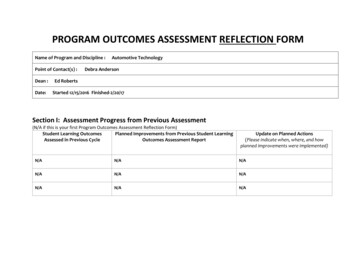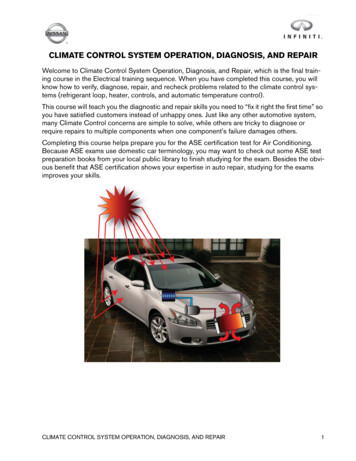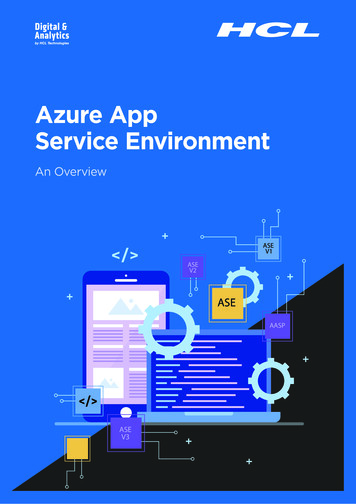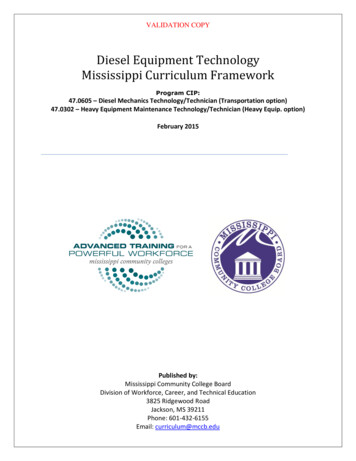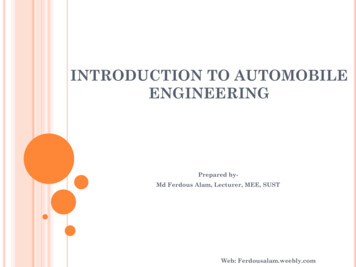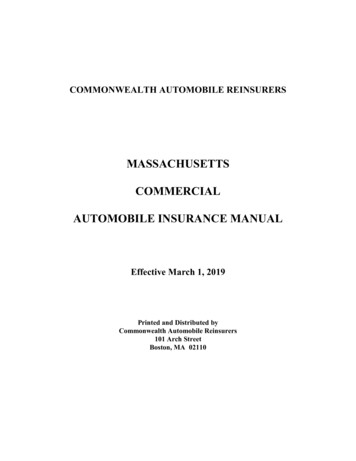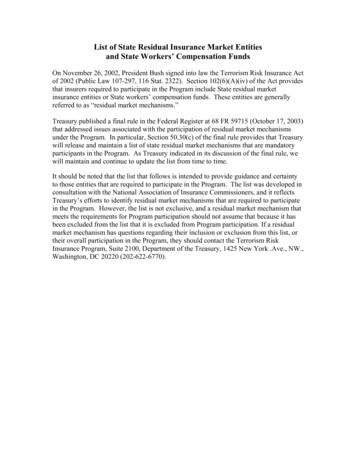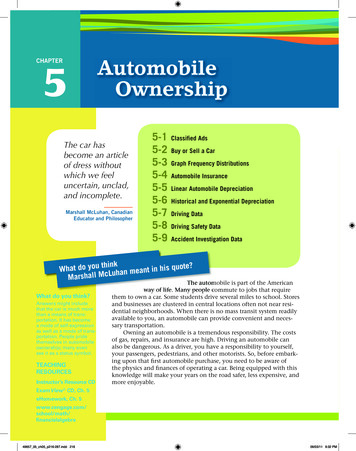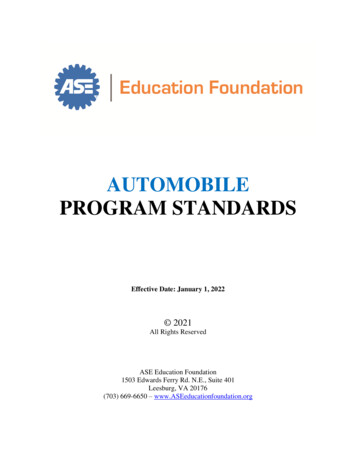
Transcription
AUTOMOBILEPROGRAM STANDARDSEffective Date: January 1, 2022 2021All Rights ReservedASE Education Foundation1503 Edwards Ferry Rd. N.E., Suite 401Leesburg, VA 20176(703) 669-6650 – www.ASEeducationfoundation.org
ContentsBACKGROUND .1AUTOMOBILE PROGRAM STANDARDS STANDARDSTANDARDSTANDARDSTANDARDSTANDARDSTANDARD1 – PURPOSE.22 – ADMINISTRATIVE PROGRAM SUPPORT.23 – LEARNING RESOURCES.34 – FUNDING.35 – STUDENT SERVICES.36 – ADVISORY COMMITTEE.47 – INSTRUCTION.58 – TOOLS & EQUIPMENT.79 – FACILITIES.810 – INSTRUCTIONAL STAFF.911 – WORK-BASED LEARNING.912 – E-LEARNING.10POLICIES .11ACCREDITATION PROCESS.11AUTOMOBILE MINIMUM REQUIREMENTS.13QUALIFICATIONS OF EVALUATION TEAM LEADERS (ETLs).16QUALIFICATIONS OF ON-SITE EVALUATION TEAM MEMBERS.17TASK LIST INFORMATION.18TOOLS AND EQUIPMENT INFORMATION.19GO/NO-GO STANDARDS.20RECOGNITION FOR ACCREDITATION.22INTEGRATED ACADEMIC SKILLS RECOGNITION.23APPEALS AND ACTION FOR REVOCATION.24DEFINITIONS – EDUCATIONAL TERMS.26POLICIES ON ARTICULATION AGREEMENTS.29PROCEDURES FOR INITIAL ACCREDITATION OR RENEWAL OFACCREDITATION .30PROCESS OVERVIEW.30ON-SITE EVALUATION COST SHEET.35SPECIAL CONSIDERATIONS FOR RENEWAL OF ACCREDITATION.36EVALUATION GUIDE .37AUTOMOTIVE PROGRAM EVALUATION.37ADVISORY COMMITTEE TASKS WITHIN PROGRAM STANDARDS.38AUTOMOBILE TASK LIST .40TASK LIST AND ASSUMPTIONS.40FOUNDATIONAL TASKS.42WORKPLACE SKILLS.44MAINTENANCE AND LIGHT REPAIR (MLR).45AUTOMOBILE SERVICE TECHNOLOGY (AST).66
MASTER AUTOMOBILE SERVICE TECHNOLOGY (MAST).92TASK LIST PRIORITY ITEM TOTALS.122DEFINITIONS – TECHNICAL TERMS.123TOOLS AND EQUIPMENT .127HAND TOOLS.128GENERAL LAB/SHOP EQUIPMENT.130SPECIALTY TOOLS AND EQUIPMENT.132
BACKGROUNDAUTOMOBILE TECHNICIAN TRAINING ACCREDITATION PROGRAMThe Board of the National Institute for Automotive Service Excellence (ASE) is responsible foraccreditation of automotive (automobile, collision repair & refinish, medium/heavy truck)programs at secondary and post-secondary levels. ASE will grant accreditation to programs thatcomply with the evaluation procedure, meet established standards, and adhere to the policies inthis document. Program accreditation is under the direct supervision of the Board of Directorsand such personnel designated or employed by the ASE Education Foundation.HistoryThe ASE standards for automobile program certification were introduced in 1982. Standards forcollision repair & refinish programs were launched in 1989 and truck standards followed in1992. The ASE Education Foundation’s role in the process was to work with industry andeducation to update the standards on a regular basis and evaluate programs against thosestandards. Based on a positive evaluation, programs are accredited by ASE for a period of five(5) years.In June 2012, a new model for automobile program standards was published. This new modelintroduced standards based on three (3) levels rather than by automobile area (brakes,electrical/electronic systems, etc). The three levels are: Maintenance & Light Repair (MLR),Automobile Service Technician (AST), and Master Automobile Service Technician(MAST). The task and tools lists were subsequently reviewed and updated in 2016 and again in2021.The Program Standards and Program Evaluation Forms were reviewed and updated in 2020 tostreamline and simplify the accreditation process. Those changes are included in this document.Programs may begin submitting applications using these materials January 1, 2022.Applications using the 2018 requirements will no longer be accepted after June 30, 2022.The cost to each program for accreditation will be as reasonable as possible to encourageprogram participation. This cost will include program evaluation materials, application(processing) fee, and on-site team evaluation materials. The honorarium and expenses of theEvaluation Team Leader (ETL) are paid directly to the ETL from the program being accredited.Effective 1/1/2022Page 1 of 134Revised 12/30/2021
AUTOMOBILE PROGRAM STANDARDSSTANDARD 1 – PURPOSETHE AUTOMOBILE TECHNICIAN TRAINING PROGRAM SHOULD HAVECLEARLY STATED PROGRAM GOALS, RELATED TO THE NEEDS OF THESTUDENTS AND EMPLOYERS SERVED.Standard 1.1 – Employment PotentialThe employment potential for automobile technicians, trained to the level for the specialty orgeneral areas outlined in the program goals, should exist in the geographic area served by theprogram.Standard 1.2 – Program Description/GoalsThe written description/goals of the program should be shared with potential students and mayinclude admission requirements if applicable, employment potential, area(s) of specialty trainingoffered, and the cost of all tuition and fees. Technical qualifications of the faculty and the overallgoal(s) of the program should also be included.STANDARD 2 – ADMINISTRATIVE PROGRAM SUPPORTPROGRAM ADMINISTRATION SHOULD ENSURE THAT INSTRUCTIONALACTIVITIES SUPPORT AND PROMOTE THE GOALS OF THE PROGRAM.Standard 2.1 – Administrative SupportPositive administrative support from institutional and local governing bodies should bedemonstrated. Indicators of administrative support would include support for staff in-service andupdate training; provision of appropriate facilities; up-to-date tools, equipment, training supportmaterials, and curriculum; and support of continuing program improvement.Standard 2.2 – Written PoliciesWritten policies should be adopted by the administration and policy board for use in decisionmaking situations and to provide guidance in achieving the program goals. Policies regardingsafety, liability, and lab/shop operation should be written and prominently displayed as well asprovided to all students and instructors.Standard 2.3 – Provisions for Individual DifferencesThe training program should be structured in such a manner that students with different levels ofcognitive and psychomotor skills can be accommodated.Effective 1/1/2022Page 2 of 134Revised 12/30/2021
STANDARD 3 – LEARNING RESOURCESSUPPORT MATERIAL CONSISTENT WITH BOTH PROGRAM GOALS ANDPERFORMANCE OBJECTIVES SHOULD BE AVAILABLE TO STAFF ANDSTUDENTS.Standard 3.1 – Service InformationService information with current manufacturers’ service procedures and specification data forvehicles manufactured within the last ten (10) years should be available. This information shouldbe accessible to students in the lab/shop area.Standard 3.2 – MultimediaAppropriate up-to-date multimedia materials and technology should be readily available andutilized in the training process.Standard 3.3 – Student ResourcesPertinent instructional texts, resources, and e-learning materials should be available for eachstudent to satisfy the objectives of the mode of instruction used. Basic and specialty learningresources should have copyright dates that are not over six (6) years old.STANDARD 4 – FUNDINGFUNDING SHOULD BE PROVIDED TO MEET THE PROGRAM GOALS ANDPERFORMANCE OBJECTIVES.Standard 4.1 – FundingAdequate funding should be allocated and used for the operation of the program. The fundingshould be allocated by the institutional administration in conjunction with the program facultywith input from the advisory committee. Funding reports should be made available to programstaff.STANDARD 5 – STUDENT SERVICESSYSTEMATIC COUNSELING SERVICES, PLACEMENT, AND FOLLOW-UPPROCEDURES SHOULD BE USED.Standard 5.1 – Pre-admission Program AdvisementPrior to program admission, a student should be counseled regarding automotive careers.Standard 5.2 – PlacementA student placement system should be used to assist students in obtaining employment inindustry, related to their training.Effective 1/1/2022Page 3 of 134Revised 12/30/2021
Standard 5.3 – Annual Graduate Follow-upA follow-up system should be used to determine graduates' employment location and forfeedback regarding the efficiency, effectiveness, and appropriateness of training. The follow-upprocedure should be designed to assure feedback regarding needed additions to or deletions fromthe training program, and tools and equipment. Follow-up of graduates employed outside of theautomobile industry should indicate reasons for non-automobile service employment. Whenapplicable, this information should be used to modify the training quality and/or content.STANDARD 6 – ADVISORY COMMITTEEAN OFFICIALLY SANCTIONED PROGRAM ADVISORY COMMITTEE MUST BEUSED TO PROVIDE INPUT ON PROGRAM GOALS.Standard 6.1 – MembershipAn Advisory Committee of at least five (5) industry members (not counting school personnel oreducators from other schools), must convene at least two (2) working meetings a year to provideinformation, counsel, and recommendations on behalf of the community served by the trainingprogram. This Committee should be broadly based and include former students, employedtechnicians, and employers. All members of the Advisory Committee should not be from thesame business.Standard 6.2 – Review of Student SurveysThe Advisory Committee should provide input and review student surveys.Standard 6.3 – Review of Program FundingThe Advisory Committee should provide input and review funding.Standard 6.4 – Review of Graduate Follow-up and Employer SurveysInformation gathered from the annual follow-up of program graduates and employer surveysshould be reviewed by the Advisory Committee to assess employment potential and provideinput on program modifications.Standard 6.5 – Review of Course of StudyThe Advisory Committee should provide guidance and approve all tasks added to or removedfrom the mandatory task list required for the program accreditation level being sought.Standard 6.6 – Review of Tools, Equipment, and FacilitiesThe Committee should conduct annual inspections of tools and equipment to assure they are upto-date and comparable to industry standards for quality and safety. The Advisory Committeeshould review information from safety inspections and conduct an annual evaluation of thefacilities to assure compliance with local, state and federal safety and environmental rules andregulations. Additionally, the committee should review all safety practices for appropriateness inmeeting program goals.Effective 1/1/2022Page 4 of 134Revised 12/30/2021
STANDARD 7 – INSTRUCTIONINSTRUCTION MUST BE SYSTEMATIC AND REFLECT PROGRAM GOALS. ATASK LIST AND SPECIFIC PERFORMANCE OBJECTIVES WITH CRITERIONREFERENCED MEASURES MUST BE USED.Standard 7.1 – ProgramThe training program should progress in logical steps, provide for alternate sequences, whereapplicable, and be made available to each student.Standard 7.2 – Preparation TimeAdequate time should be provided for teacher preparation and program development.Standard 7.3 – Teaching LoadThe instructor/student ratio and class contact hours should allow time for interaction on a one-toone basis. A safe working environment should be considered when determining teacher/studentratio.Standard 7.4 – Course of StudyAll tasks in the program task list have been given a priority rating. A specified minimumpercentage of tasks rated P-1, P-2, and P-3 (Automobile and Truck programs) or HP-I and HP-G(Collision programs) must be included in the course of study, based on program’s accreditationtype and level. Instruction on the legal aspects and responsibilities of the service technician inareas such as Environmental Protection Agency regulations, safety regulations, OSHAregulations, and other appropriate requirements must be included in the curriculum. Instructionand practice in filling out work order forms, ordering parts, and basic record keeping should be apart of the training program. Tools and equipment must be available to perform the tasks in eachof the areas for which accreditation is requested.Standard 7.5 – Performance Standards and Student ProgressAll instruction should be performance based, with an acceptable performance standard stated foreach task. These standards should be shared with students and potential employers. A record ofeach student's progress should be maintained. The record should indicate tasks required forprogram completion and students should demonstrate competency of a task.Standard 7.6 – Safety StandardsSafety instruction must be given prior to lab/shop work and be an integral part of the trainingprogram. A safety test must be included in the training program. Students and instructors shouldcomply with personal and environmental safety practices associated with clothing; eyeprotection; hand tools; power equipment; proper ventilation; and the handling, storage, anddisposal of chemicals/materials in accordance with local, state, and federal safety andenvironmental regulations.Effective 1/1/2022Page 5 of 134Revised 12/30/2021
Standard 7.7 – Personal StandardsAll training activities and instructional material should emphasize the importance of maintaininghigh personal standards.Standard 7.8 – Work Habits/EthicsThe training program should be organized in such a manner that work habits and ethicalpractices required on the job are an integral part of the instruction.Standard 7.9 – Related InstructionInstruction in related mathematics, science, communications, and interpersonal relations shouldbe provided and coordinated with ongoing instruction in the training program.Standard 7.10 – TestingBoth written and performance-based tests should be used to validate student competency.Students should be encouraged to take industry recognized certification tests, such as the ASEEntry-Level Certification tests, the ASE Professional Certification test, and EPA-approvedSection 609 credentials.Standard 7.11 – Evaluation of InstructionInstructional procedures should be evaluated in a systematic manner. This evaluation should bethrough regular reviews by students and the administration.Standard 7.12 – On-Vehicle Service and Repair WorkOn-vehicle service and repair work should be scheduled to benefit the student and supplementongoing instruction on items specified in the task list. A student should have had instruction andpractice on a specific repair task before on-vehicle service and repair work requiring that task isassigned. Vehicles donated by the manufacturers or other sources, customer-owned vehicles, andother training vehicles may be used as the primary source of on-vehicle service and repair work.Training program student-owned vehicles, school buses, and other vehicles owned and operatedby the governing body of the school must not be the primary source of on-vehicle service andrepair work vehicles. All vehicles in the lab/shop should have a completed industry-type workorder attached to or on the vehicle.Standard 7.13 – Customer VehiclesA systematic method of collecting, documenting, and disbursing customer vehicle work repairreceipts should be used. Instructional staff should not be required to collect payment forcustomer vehicle work repairs. (This applies only to programs that accept customer vehicles forinstruction.)Standard 7.14 – ArticulationAgreements between programs with equivalent competencies should be used to eliminateunnecessary duplication of instruction and foster continued study.Effective 1/1/2022Page 6 of 134Revised 12/30/2021
STANDARD 8 – TOOLS & EQUIPMENTTOOLS AND EQUIPMENT USED MUST BE OF THE TYPE AND QUALITY FOUNDIN THE REPAIR INDUSTRY AND MUST ALSO BE THE TYPE NEEDED TOPROVIDE TRAINING TO MEET THE PROGRAM GOALS AND PERFORMANCEOBJECTIVES.Standard 8.1 – SafetyEquipment and tools used in the training program must have all shields, guards, and other safetydevices in place, operable, and used. Safety glasses must be worn by all students, instructors, andvisitors in the lab/shop area while lab is in session.Standard 8.2 – Quantity and QualityThe tools and equipment used in the training program should reflect the program goals andperformance objectives. Sufficient tools and equipment should be available for the trainingoffered. The tools and equipment should meet industry quality standards.Standard 8.3 – Consumable SuppliesSufficient consumable supplies should be readily available to assure continuous instruction.Standard 8.4 – Preventive MaintenanceA preventive maintenance schedule should be used to minimize equipment down-time.Standard 8.5 – ReplacementAn annual review process should be used to maintain up-to-date tools and equipment at industryand safety standards. Graduate follow-up surveys and Advisory Committee input should be usedin this process.Standard 8.6 – Tool Inventory and DistributionAn inventory system should be used to account for tools, equipment, parts, and supplies.Standard 8.7 – Parts PurchasingA systematic parts purchasing system should be in place.Standard 8.8 – Hand ToolsEach student should have access to basic hand tools comparable to tools required foremployment. Students should be encouraged to purchase a hand tool set during the period ofinstruction.Effective 1/1/2022Page 7 of 134Revised 12/30/2021
STANDARD 9 – FACILITIESTHE PHYSICAL FACILITIES MUST BE ADEQUATE TO PERMIT ACHIEVEMENTOF THE PROGRAM GOALS AND PERFORMANCE OBJECTIVES.Standard 9.1 – Training StationsTraining stations (bench and on-vehicle service and repair work) should be available in the typeand number required for the performance of tasks outlined in the program goals and performanceobjectives.Standard 9.2 – SafetyThe facilities should meet all applicable safety standards and an emergency plan should be inplace and posted in all classrooms and lab/shop areas.Standard 9.3 – Facility MaintenanceA written maintenance program policy should be used to ensure facilities are suitable forinstruction.Standard 9.4 – HousekeepingThe classroom(s), lab/shop, and support area(s) should be kept clean and orderly.Standard 9.5 – Office SpaceAn area separate from the lab/shop should be available and convenient for the instructor(s) to useas an office.Standard 9.6 – Instructional AreaA classroom convenient to, but separate from, the lab/shop area should be available forinstruction and other non-lab/shop activities.Standard 9.7 – StorageStorage areas for tools, parts, supplies, and automobiles should be sufficient to support theactivities outlined in the program goals and performance objectives. Security should be providedto prevent pilferage and vandalism.Standard 9.8 – Support FacilitiesClean-up areas should be provided for both male and female students and should be convenientto the instructional area.Standard 9.9 – VentilationAn exhaust fume removal system should be in place and operational. When appropriate, heatingand cooling systems should be used to provide sufficient comfort for learning.Standard 9.10 – First Aid KitIf allowed by school policy, a first aid kit should be in place and should be maintained andcomply with local regulations and school policy.Effective 1/1/2022Page 8 of 134Revised 12/30/2021
STANDARD 10 – INSTRUCTIONAL STAFFTHE INSTRUCTIONAL STAFF MUST HAVE TECHNICAL COMPETENCY ANDMEET ALL STATE AND LOCAL REQUIREMENTS FOR ACCREDITATION.Standard 10.1 – Technical CompetencyInstructors must hold current ASE certification to meet the requirements of the program’s typeand level of accreditation.Standard 10.2 – Instructional CompetencyInstructors should meet all state, local, or institutional teaching requirements.Standard 10.3 – Technical UpdatingFaculty members should be provided technical materials required to maintain their competency.Instructors must complete a specified minimum amount of technical update training each year.Standard 10.4 – SubstitutesA written policy regarding the use of “substitute" instructors should be provided to allinstructors.STANDARD 11 – WORK-BASED LEARNINGWRITTEN POLICIES AND PROCEDURES MUST BE USED FOR ALL PROGRAMSANCTIONED WORK-BASED LEARNING AND APPRENTICESHIP ACTIVITIES.(This standard applies only to programs that are using work-based learning orapprenticeship training to meet minimum program hour requirements for the program’stype and level of accreditation. A maximum of 25% of the instructional-hours requirementmay be met by applicable work-based learning activities, e-learning activities, or acombination of both work-based learning and e-learning activities.)Standard 11.1 – StandardsThe work-based learning component must be an integral part of the automotive program andavailable to all students. Students spend part of the scheduled time, either on a daily basis or in ablock-time configuration, on-site in related classroom instruction and part of the scheduled timeoff-site in a related and structured work environment.Standard 11.2 – AgreementsAll legally binding agreements should be written and signed by the student, the student's parent(if the student is under 18 years of age), the employer and the program instructor or theinstitution's designated work-based learning coordinator.Effective 1/1/2022Page 9 of 134Revised 12/30/2021
Standard 11.3 – SupervisionA supervising automobile instructor or supervising work-based learning coordinator should beassigned responsibility, authority, and time to coordinate and monitor work-based learningcomponents.STANDARD 12 – E-LEARNINGWRITTEN POLICIES AND PROCEDURES MUST BE FOLLOWED WHENE-LEARNING CURRICULAR MATERIALS ARE USED OUTSIDE OF SCHEDULEDCLASSROOM/LAB/SHOP TIME.(This standard applies only to programs that are using e-learning to meet minimumprogram hour requirements. A maximum of 25% of the instructional-hours requirementmay be met by applicable work-based learning activities, e-learning activities, or acombination of both work-based learning and e-learning activities.)Standard 12.1 – AccessStudents must have access to the appropriate technology needed to access e-learning materials.Standard 12.2 – Curriculum and Student ProgressAll content/tasks taught by e-learning must be identified and a record of each student’s progressmust be maintained through the use of a Learning Management System (LMS).Standard 12.3 – Advisory Committee InputE-learning, for the purpose of meeting hour requirements, should be discussed and approved bythe Advisory Committee.Effective 1/1/2022Page 10 of 134Revised 12/30/2021
POLICIESACCREDITATION PROCESSProgram EvaluationThe accreditation process begins with an extensive program evaluation performed by trainingprogram instructors, administrators, and advisory committee members. Members of this groupcompare the program to national standards and have the opportunity to make improvementsbefore submitting the application and a summary of the evaluation to the ASE EducationFoundation.Application ReviewThe application for Initial Accreditation or Renewal of Accreditation is sent to the ASEEducation Foundation, where it is reviewed to determine if the program qualifies for an on-siteteam evaluation.Programs will have a maximum of 12 months to complete the accreditation process from the datetheir completed application for Initial or Renewal of Accreditation is received by the ASEEducation Foundation. After 12 months, the program must submit a new application. This 12month time frame may be shortened when applying under standards that are in the process ofbeing phased out.Renewal of AccreditationProgram accreditation is valid for five (5) years. Programs seeking accreditation renewal shouldsubmit a renewal application at least six months prior to their program’s accreditation expirationdate. If the program has not completed the renewal process prior to the program’s accreditationexpiration date, the accreditation will expire, and the program will be removed from the ASEaccredited programs list. Programs whose accreditation has expired will have 60 days postexpiration to submit a renewal application under current program requirements. Any programwhose accreditation is expired beyond 60 days must follow the Initial Accreditation applicationprocess.On-Site EvaluationIf the program qualifies, an Evaluation Team Leader (ETL), an educator (current or retired), of aan accredited program, trained by the ASE Education Foundation and with current ASE mastercertification credentials, is assigned to the program and an on-site visit is conducted.Recommendation for AccreditationWhen the standards are met, ASE program accreditation is valid for five (5) years from theofficial accreditation date issued. If a currently accredited program successfully completes theaccreditation renewal process before the expiration date of the current five year accreditationtimeframe, accreditation renewal does not begin until the current expiration date.Effective 1/1/2022Page 11 of 134Revised 12/30/2021
If an accredited program fails to complete the accreditation renewal process before the expirationdate of the current accreditation timeframe, the program accreditation ends until the renewalprocess has been successfully completed.Programs having difficulty in meeting the hours or tools & equipment accreditation requirementsshould consider the following options:A. Borrowing equipment needed for instruction from a manufacturer, dealership, orindependent repair shop.B. Arranging for instruction on tasks requiring equipment not available in the schoolprogram at a dealership or independent repair shop.Programs choosing option A or B are required to show documentation on where the tasks aretaught, by whom, and how students are evaluated.Effective 1/1/2022Page 12 of 134Revised 12/30/2021
AUTOMOBILE MINIMUM REQUIREMENTS1. The minimum program requirements are identical for Initial Accreditation and forRenewal of Accreditation.2. Programs must meet the following hour requirements based on the level of accreditationsought.Maintenance & Light RepairAutomobile Service TechnologyMaster Automobile Service Technology540 hourscombined classroom andlab/shop instructional activities840 hourscombined classroom andlab/shop instructional activities1200 hourscombined classroom andlab/shop instructional activities3. The average rating on each of Standards 6, 7, 8, 9 and 10 must be a four (4) on afive-point scale. The program will not be approved for an on-site evaluation if theaverage is less than four (4) on any of those standards. The program should makeimprovements before submitting the application to the ASE Education Foundation forreview. A program will be denied accreditation if the on-site evaluation teamaverage rating on Standards 6, 7, 8, 9 or 10 is less than four.4. A “YES” response must be achieved on all six (6) criteria in Standard 12 if the programis using it to meet the instructional hour requirements for the purpose of accreditation.The program will not be approved for an on-site evaluation if it cannot support a “YES”response to each criterion on the program evaluation form. A program will be deniedaccreditation if the on-site evaluation team does not give a “YES” response to all six(6) criteria in Standard 12. This applies only to programs using the provisions inStandard 12 for the purpose of meeting instructional hour requirements.5. A program may not be approved for an on-site evaluation if the average rating onStandards 1- 5 and 11 is less than a four on a five-point scale. A program may bedenied accreditation if the on-site evaluation team average rating on Standards 1 - 5and 11 is less than four. Approval for on-site evaluation or accreditation will be madeby the ASE Education Foundation, based on the number of standards rated at 4 or 5 aswell as the individual rating on any standard rated less than four.Effective 1/1/2022Page 13 of 134Revised 12/30/2021
6. MLR: All MLR instructors must hold current ASE certification in Auto Maintenance &Light Repair (G1), Suspension & Steering (A4), Brakes (A5), and Electrical/ElectronicSystems (A6).AST: All AST instructors must hold current ASE certification in Auto Maintenance &Light Repair (G1), Electrical/Electronic Systems (A6
The Board of the National Institute for Automotive Service Excellence (ASE) is responsible for accreditation of automotive (automobile, collision repair & refinish, medium/heavy truck) . The ASE standards for automobile program certification were introduced in 1982. Standards for . The instructor/student ratio and class contact hours should .
